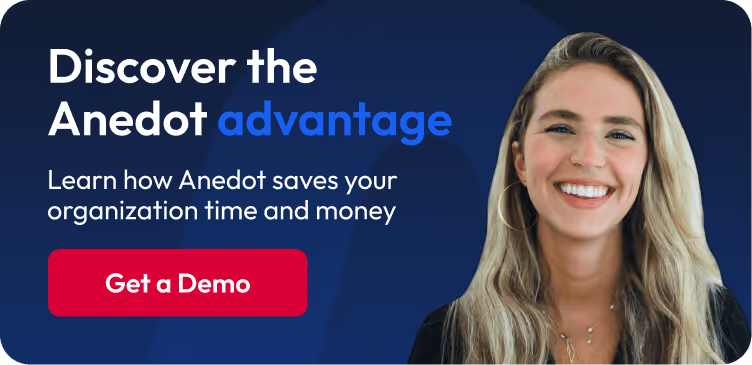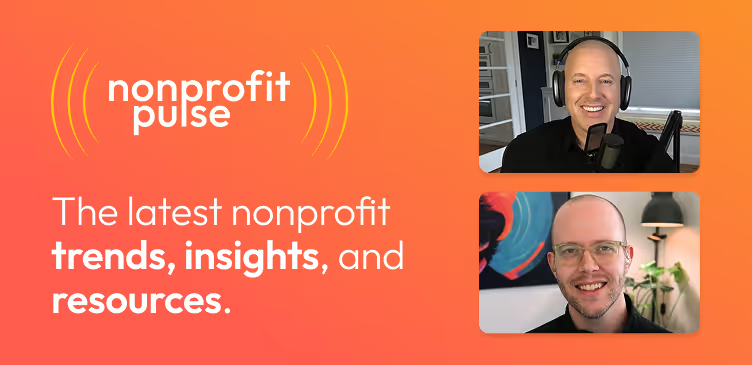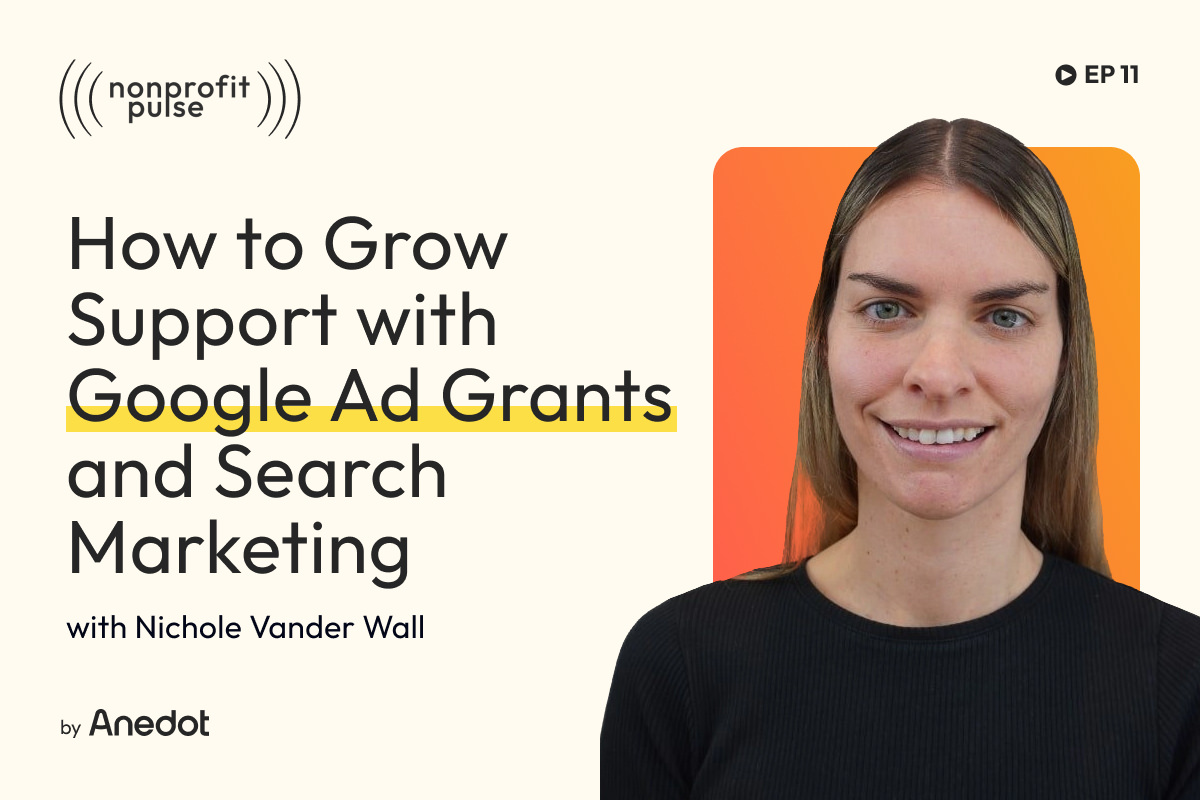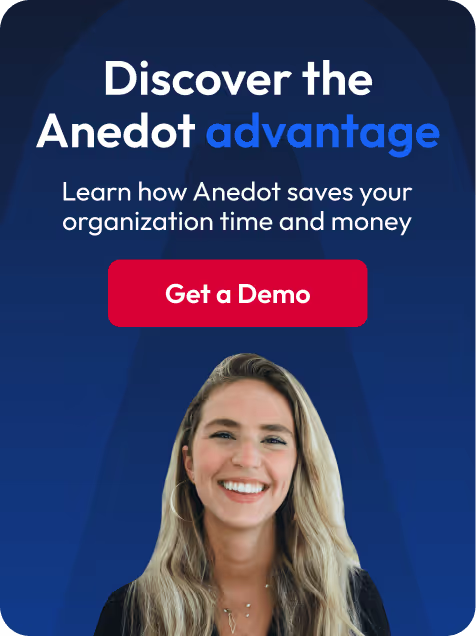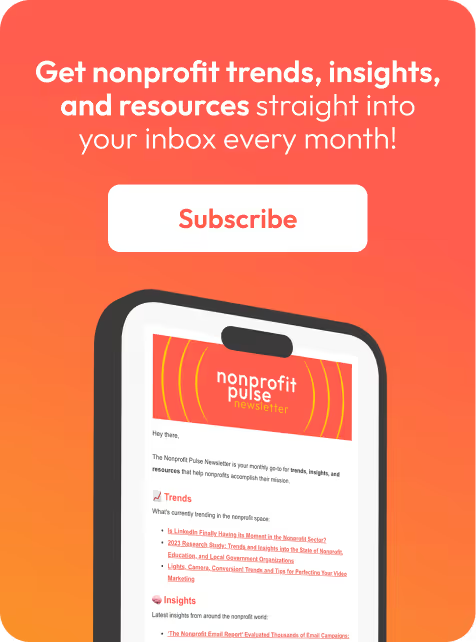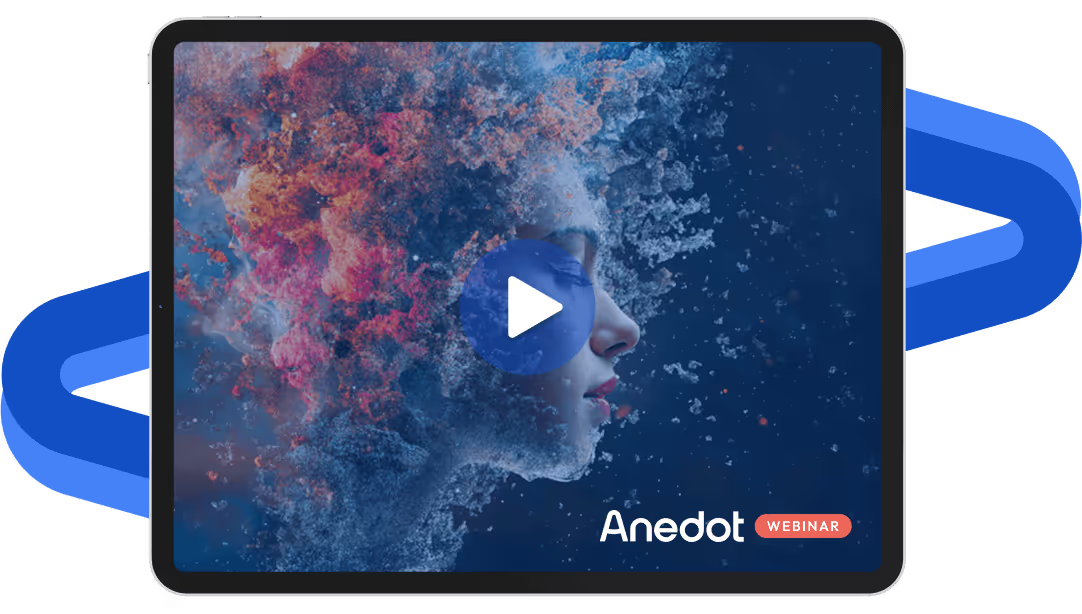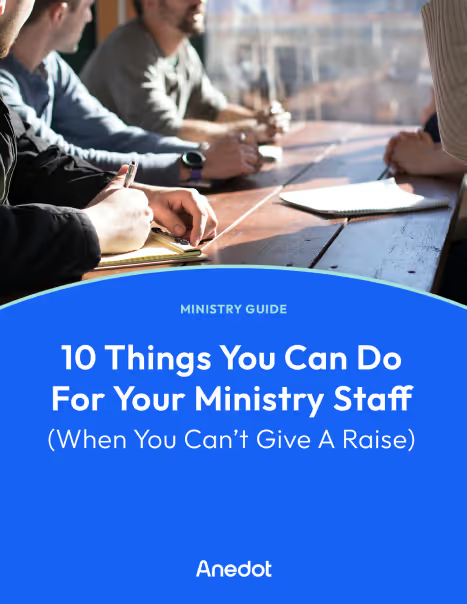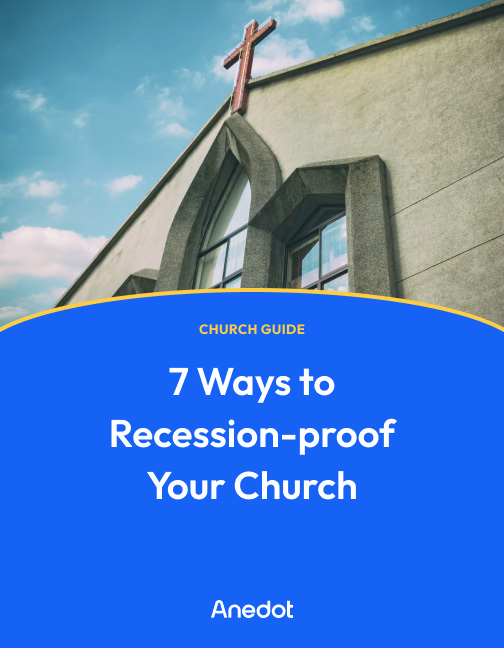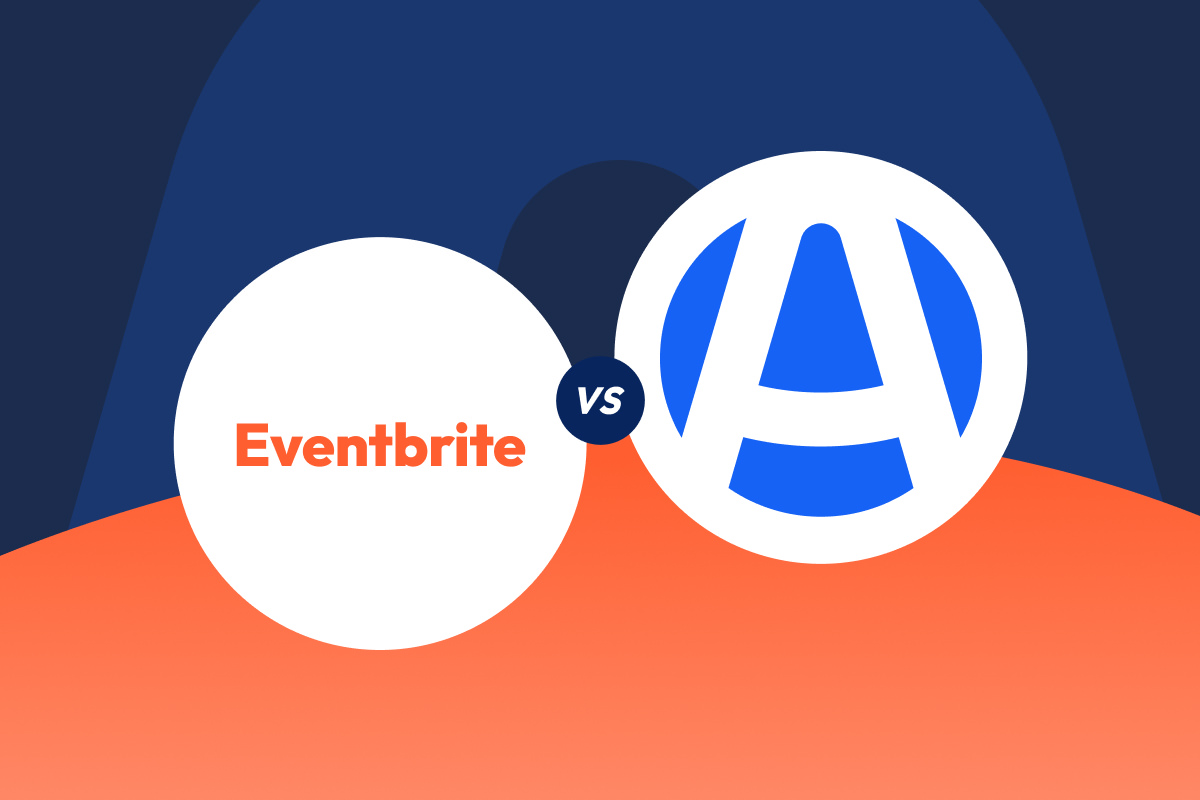Podcast episode transcript ↓
Josh:
Sometimes the best marketing campaigns don't cost a thing.
Currently, most nonprofits are not taking advantage of one of the best opportunities in nonprofit marketing: Google Ad Grants.
But, how do you get started and what are the best practices for the program and more broadly, nonprofit search marketing?
I'm Josh with Anedot and welcome to Nonprofit Pulse where we explore trends, insights, and resources that help nonprofits accomplish their mission.
On this episode, we're joined by Nichole Vander Wall on the topic of Google Ad Grants and nonprofit search marketing best practices.
Nichole is a search marketing expert, helping nonprofits attract supporters with Google Ad Grants using a simplified process taken from the Ad Grant Accelerator framework.
With more than 10 years of experience serving nonprofits, Nichole helps organizations thrive in their search marketing efforts through expert coaching and consulting.
Hey Nichole, thanks so much for coming on the podcast.
Nichole:
Yeah, thanks for having me. I'm really excited to go through this today with you.
Josh:
Yeah. So I've been excited for this conversation for a while. We've been trying to get this booked for many months.
You are in Australia and I am in Austin, Texas, so it's been a bit of a dance to get the schedule worked out, but we made it.
We are here and super excited to be talking about Google Ad Grants for nonprofits.
Just a great resource for our community and there's always more education to be had in the area. So super excited about the topic.
What are Google Ad Grants and how is the Google Ad Grants application structured?

Josh:
So maybe just first of all, let's define what we're talking about.
For those who are not initiated, what are Google Ad Grants and why should nonprofits care about them?
Nichole:
Yeah, fabulous question. And I’d love to just jump in just straight away and just get into it.
So the details are, if you are a registered nonprofit in most countries in the world, not just the US, you are eligible for a 10,000 USD per month advertising grant that is run on the Google platform.
So $10,000 generally on the Google platform, you'll get a click will be anywhere from $2 to potentially $30.
So Google gives you that $10,000 to spend throughout the month on clicks to your website.
So when we talk about Google, it's Google search ads.
So when you type something into Google, events near me or what's on this weekend, you'll generally see a few advertisements at the top. There will generally be about three ads and they'll have a little sponsored or ad next to them, and that's how we know they’re advertisements.
So with the Google grant, Google allows you to basically run free advertisements for your charity to show up on the results page in order to get new people to your website that might not know about your organization already.
And it's really Google's way of giving back to charities and nonprofits so that you guys can really get the most of people that are searching for your cause or your mission or potentially your services that wouldn't otherwise know about you.
So we're talking about 10,000 a month here, which is 120,000 per year, which is a massive, massive budget, especially for a nonprofit for potentially your nonprofit that might not have heaps of money to spend on advertising.
This is just really a really great offering and really to get it, just to jump into how to get the Google grant, it's a very short application process.
You know, the Google Ad Grants application will generally take you anywhere from ten to potentially a full hour to go ahead and apply, but then that's pretty much it.
Anyone can do it. You don't need to be like in the grants department or a grant specialist to apply for this grant. It's really just asking you a few different questions about your organization.
→ Learn the best practices on how to write a grant proposal!
It will validate with the organization named Percent that you are actually a valid nonprofit, and then once you are approved, which can be anywhere from 24 hours to a whole week, then you’ll all of a sudden just have this new budget released and you'll have this whole new fresh advertising account that you'll be able to set up these ads.
And yeah, you're sort of off to the races.
It's one of the easiest, in my opinion, grants to get because, you know, typically when we think about getting a grant, it's like we have to write out a whole different thing.
We have to generally hire like potentially a grant writer to help us write it. We need to consult with different people to put the best application together.
But this is like, if you're a nonprofit, you're eligible, you're likely going to get it.
So they're sort of there's not a big margin to get into this game. So it's that's why I think it's really special in that sense.
But yeah, also really easy to get just for any nonprofit marketer.
What's new in the Google Ad Grants program?

Josh:
Yeah, it really seems like a win win for both Google and the nonprofits in that you know, with Google ads, it introduces nonprofits who may not be advertising or who may not be advertising on Google, kind of introduced to their platform.
And for nonprofits, it's a great program to get free advertising spend and then also to get acquainted with the Google ad platform and perhaps even just advertising in general.
So it's a really great program, highly recommend it.
What's new in the Google Ad Grants program? What are you seeing?
Nichole:
Yeah, so that's a really great question. And to be honest, like with, so the Google grant, I should say, is only search advertising.
So you can't necessarily run any of your like display ads or any YouTube activity. So if you want to do any like video or image ads, you won't be able to do those in your Google grant.
It's just search advertising. So just search keywords. Just you know the top three ads when you search for something on the results page.
But that being said, what is new and it's kind of exciting because the Google grants are a little bit slow in getting new sort of initiatives or advancing compared to paid ads.
So what is new is that we're seeing in a lot of our grants lately is that they're surpassing the $10,000 budget.
So that just means like historically, you would only be able to spend a certain amount per day like generally capped out around 328 per day of spend.
But now we're seeing Google sort of opening that a little bit. So we're seeing clients that historically only were able to spend 10,000 a month going up to 11,000 and a little bit further up.
So I guess like the call out is if you have a grant, a Google grant active now and you're potentially watching or listening to this podcast, I would say that go ahead and open your daily budgets up a little bit because you may want to, there may be additional spend that you just don't know about.
So if you're one of those people who you've set all of your daily budgets to only hit that 328, I would go ahead and pop those up a little bit and maybe even up to 500, because we know Google is allowing nonprofits to spend more and you really want to be able to capture that additional opportunity.
Same goes if you don't have a Google grant yet, just keep that in mind. You don't want to really restrict it to just 328 or that 300 per day.
Keep it a little bit open because you potentially might get a little bit more than that ten grand per month.
Strategies to effectively use Google grants for nonprofits

Josh:
Yeah. So Nichole you help organizations run their advertising programs through Google Ad Grants.
What are you seeing that's really working for nonprofits? What do you see tactic, strategies, etc. that you could share with our audience?
Nichole:
Yeah, definitely.
So the number one, like if we were talking about the list of priorities of what to set up in your ad grants account, and I can like literally go on for days of telling you about like the top ten list.
But if we're just talking the number one priority of what to set up in your grant today, that can make a difference tomorrow is going to be a brand campaign.
So a brand campaign is just anyone who is typing in your brand keyword, your brand name as a keyword I should say.
So if you are if you’re Susan G. Komen, someone typing in Susan G. Komen walk, Susan G. Komen race, donate to Susan G. Komen.
These are all people typing in your brand keyword, so they technically likely already know about your brand, right?
So setting up a search campaign using your brand keywords. So these can be exact match type, phrase match type or broad.
It doesn't really matter with your brand, but you want to go and have at least five brand keywords in your brand search campaign. And then what you want to do is your advertisement on that campaign, you want to make sure that your call to action is very strong.
So your absolute like how you judge success of your organization. So for most organizations, it's going to be "donate now," you know, some organizations might be, you know, "buy a ticket to our event," or whatever your main the main way that you make money for organization that needs to be your call to action on your brand advertisement.
So like a good example, I was working with a client about two weeks ago and we just updated her brand ads.
We did nothing else in the account. We just updated the brand ads to be really strong, you know, donate now, we need your urgent support.
You know, we need your help in order to keep 17 support groups running just very, very strong call to action, you know, really using positive sentiment and "donate now" is the call to action.
And we came back a week later and someone had already made a $300 donation just within the first week, which is like crazy for grant because generally grants are a little bit slower.
But to see a donation within seven days just in the brand campaign from changing one small thing is pretty unheard of.
So just make sure if or when you do create your brand campaign or if you have one right now, that your call to action is very strong and it's really what you want those users that potentially already know your brand, already have that know I can trust, what you want them to do, like what action you want them to take on the site.
Josh:
I love that and I love the story. And you know what? That's essentially free money, right?
And we were talking about nonprofits who are so often scraping for resources, trying to make every dollar count, using these ad grants to gain new donors and not just donations, but even donors. Right?
Like donor cultivation, building new relationships with those who are going to support you.
That's just it's huge. And especially this time of the year, you know, everyone's doing the end of year giving push and it's just a great year, too, or a great time to be leaning into your grants.
So what would you say as far as next steps for those who let's say they've gotten the grant, maybe they're unsure what to do next.
You know, obviously they can contact you for help. But even beyond that, what would you say if they're already plugged in, what's some good next steps for them?
Nichole:
Yeah, definitely.
So I think if you already have your grant and you've been approved and you've potentially been running for a couple of weeks and you're just really not seeing the spend that you're after, which is very, very common.
When I do help clients with their grants generally, they can only spend a couple hundred and they really want to spend that 5,000 or that 10,000.
So generally what I recommend is setting up a dynamic search campaign. So this is sort of one of the, I guess I should say, like sneaky or like hack campaigns that you can actually set up in the grant account.
So this is a search campaign technically, but it's dynamic. So it's sort of like it's definitely allowed, but it's like sort of on like the gray area between what is and isn't.
But generally this dynamic search campaign instead of using keywords. So instead of giving a bunch of keywords you want to target, you give it your landing pages and Google will do the hard job of finding all the keywords that you currently have on site or on your landing pages that you give it, and then they will run advertisements.
So you don't necessarily write an advertisement with a bunch of headlines or a landing page. You just give Google two description lines and then they'll do all of the other work.
So it's something to keep in mind if you, so basically the advertisement is dynamic. Google will dynamically put this together.
So if you are worried about like your brand image or you have a very specific or strict brand guide, this campaign probably isn't for you.
But if you aren't so much worried about your advertisements and sort of what they're going to look like, then I would definitely recommend this type of campaign.
Again, you just set up like your generic search campaign. However, when you go to make the ad groups, it will send you into making standard ad groups.
You’ll just want to exit out of the process and then you want to rebuild once the campaign sort of is in the left navigation, you want to go back into it, create a new ad group, but change it.
There's like a down arrow. You can change from standard to dynamic.
So you want to create a dynamic ad group and then you'll go ahead and choose either all landing pages or all ad groups from standard campaigns, whatever you want to choose as you're targeting.
And then it’ll just pop in two description lines. And that's basically it. So it's really you don't really need hardly any content or information to get started.
And just one thing to mention, if you do build this dynamic campaign and you notice that Google is not suggesting any landing pages or it isn't spending or it isn't serving, then it's possible that Google can't find any keywords on your website, and that happens when you have a new website, perhaps you’ve only, you know, your organization is only a year old or it's a new website.
Perhaps you do not know anything about nonprofit SEO and you haven't set up or optimized any keywords on site, then that's going to be a massive reason why your dynamic ad might not work.
And if that is the case and dynamic isn't working for you, then you're going to have to go back to that generic search utilizing your exact phrase match, and then you still can't spend with the exact phrase and you have to really jump into broad match keywords and really utilizing more broad generic keywords to go ahead and get your account to spend.
You can also like you can also target adjacent categories to yourself. So what might your target audience be searching for that’s similar to what you have?
So you do have to have like a landing page on your website that talks about whatever this is, but you definitely can utilize your grant to target things that are similar to what you offer, similar services to what you offer.
Not necessarily. It doesn't necessarily have to be just all what you have. You can sort of branch out into different areas to capture more audience and to get more people to your website.
But again, you need to have a designated landing page on your site that speaks about that adjacent offering, if that makes sense.
Google Ad Grants common mistakes

Josh:
What are some other common mistakes that you've run into organizations you're trying to do with the grant or having issues with the ad showing or even reporting?
What are some common issues there?
Nichole:
Yeah. So the number one common mistake that people make and I guess I really didn’t talk about this, so glad you bring this up.
But so with your grant account, the number one rule to understand is that you can never compete against a paid advertising account. So you are in the second priority line in the auction.
So you can. So basically you'll never be able to run keywords like "donate to charity." If you have a bunch of high competitive keywords in your grant account, like "donate to charity," you know, like donate to whatever it might be, you know, "walk for charity," "5K walk for charity."
Those sort of like really high competition keywords in your grant account, they're not going to run. You won't get any spend, you won't get any impressions.
A lot of times when I'm looking at ad brand accounts or auditing through, I notice that all of the keywords are super high competition keywords. And I think that this really isn't very clear to advertisers of nonprofits when they first get their grant. There's absolutely no reason to even have these high competition keywords in your account because you're never going to show for like a "donate to charity" or like "donate" type of keywords.
This is sort of reiterating, if a paid advertiser, so if a nonprofit with real money, so like, you know, your bigger nonprofits that spend thousands of dollars per month advertising on keywords like donate to charity, you know, donate to whatever children's charity, donate to cancer, all of these keywords, if anyone is paying real money, they're real money to bid on those, your grant will never show on that keyword.
So you're in a second priority line at all times and you can never sort of jump the queue or get ahead of them. You're basically being being sold leftover impressions, left over space on the results page.
So that in mind you need to go for keywords that are medium to low competition.
Keywords that technically other paid advertisers might not be bidding on. And so those keywords are going to be more of like your middle to top funnel keywords, right?
So if you know, you have, if you are trying to get, you know, if you're like a leukemia lymphoma society of the US or something and you're trying to get donations for people that are struggling with cancer.
Obviously you cannot use like "donate to cancer" or "donate to cancer charity," those keywords are going to be too competitive.
Those have to live in a paid account. If you're going to bid on them, they have to be in a separate account.
But the keywords you will go for in your grant are like the different types of cancer, you know, signs and symptoms of those different types of cancers, you know, potentially like those mid to high funnel keywords that are more people in like the research phase, right?
So it's more of like people that are just looking around and researching that you want to capture with your grants and then sort of those bottom funnel keywords live in a separate paid account if you do have additional budget available for those.
Josh:
Yeah. So and I imagine with underserved causes, there might be an a bit of an advantage there, right? That these major keywords are not being bid on by paying ad customers.
So there may be depending on what your nonprofit is focused on and who you're serving, there may be opportunity there to actually get a significant amount of traffic regardless of of, you know, what the current competition is.
And then secondly too, it's made me think, Nichole, that however your ads are performing on the ad grant, don't equate that to what a true paid ad campaign might produce.
Nichole:
Yes 100%. 100 100%. So if you think about your ad grant, you can never so like how people generally judge how the share of what their ads are getting. It's called impression share.
So a lot of people try to go for 100% impression share on their brand keyword, which means that of all the impressions, of all the eyeballs of people seeing ads, you're getting 100% of them.
So in your grant, you can never even get like around 50 to 60. Like it's just it's not it's not based on the whole because you're not being able to see the whole.
It's something that you need to keep in mind is that your impression share will never match up to a paid account. So you can say, my grant has like 100% impression share.
It likely does not. It likely has 100% of the impressions it can receive. But there's others that we know that it can't.
So it's like something to just keep in mind. I see a lot of people like saying, we have like 50% impressions share in the grant or we have 100% on our brand keywords in the grant.
And I'm like, no, like there's still other impressions, incremental impressions that you could be getting in a paid account as well.
Should nonprofits run both Google Ad Grants and paid Google Ads accounts?

Josh:
Would you recommend nonprofits run paid accounts alongside their grant account?
Nichole:
Yeah, definitely. So this is like a really good question. And I think that there's a couple of things that I generally like go through with a nonprofit to see if they're a good fit.
The first being like if they have a good amount of budget, So good amount of budget, like we're talking about 5,000 a month at a minimum. Like generally like you can spend less than that, right?
But you do need a good amount of budget to sort of have a second paid ads account and do well sort of in the charity space because there is so much competition.
I would say if you have between three and $5,000 you can spend per month, then it is probably a really good fit for you to try out search ads.
And then the second part about being is like, have you monetized, has your nonprofit monetized?
So when I say that, is there a way when someone lands on your website, can they purchase something from you?
And if that is yes, then you are definitely a good fit for advertising.
Also a little caveat. If you are an e-commerce shop and you're a nonprofit, you 100% should be having a separate sort of e-commerce paid ads account that has like your shopping feed and shopping campaigns and everything like that. That sort of stuff can't sit in the grant either.
So yeah, just to sort of recap, if you have an e-commerce store, you should definitely have a paid ads account regardless sort of of your budget.
The second being, if you have a little bit of incremental budget with your organization to spend on a monthly basis. So let's say 3 to 5,000 and then yeah, I think I think, gosh, I forgot the third one that I said, but I think that's pretty much it.
And I think you want to go at least three months. So if you have an appeal coming up, you want to do like get your campaign set up, do a little bit of prospecting through the first month, potentially second month and then the third month just being like that hard conversion sale.
But yeah, I would say at least three months you want to sort of build up. A lot of nonprofits say, we have like a three week appeal and it's like, that's not going to work for advertising.
It might, but it's not going to be something that it's not going to be scalable, like you're not going to have good enough learnings from such a short campaign because the machine learning and the bidding takes a few weeks to learn to be able to drive conversion.
So you need to sort of keep that in mind with running sort of short term campaigns, it’s going to be really tricky for your campaigns to work well.
Closing thoughts

Josh:
Nichole this has been so helpful. Any resources you would recommend to our audience?
Nichole:
Yeah. So I right now I am hitting my YouTube channel pretty hard.
So I'm uploading content twice a week of just optimizations or just like having to look into the grant accounts that I run and sort of like giving recommendations and showing what works.
So go ahead and head over to my YouTube channel. It's just my name, Nichole. N-I-C-H-O-L-E.
And then Vander Wall just how it sounds and then you'll be able to see sort of all of like seriously all my content.
It's a pretty big vault at this point. And yeah, like all the clients that I work with are really understanding and want to help other nonprofits.
So they're really open with me showing, you know, their accounts and like how I'm doing them and what's working.
So if you are interested in even getting the grant or what's working or how to do it, go on, head to my YouTube channel and subscribe and you’ll be able to see all of my courses as well that are on my website sort of through my YouTube channel.
Josh:
Awesome. Awesome. Yeah. And if you check out the show notes at Nonprofitpulse.com, we'll have all of Nichole’s links there as well as links for the Google Ad Grants.
Nichole, thanks so much for sharing about Google Ad Grants and just advertising in general and I hope it's spurred our audience on to maybe pursuing this in 2024 and beyond.
And hopefully they will reach out to you and get some trusted expertise on if they do run their campaigns.
Nichole:
Yeah. Thank you so much. Thank you. It's so fun to talk back to someone in the US because I'm missing my American family here in Australia.
So really good to chat with you, too.
Josh:
Yes, I'm so glad we got it worked out.
Hey, thanks for checking out this episode!
If you enjoyed it, please share it with others or leave us a rating and review.
To find show notes and resources mentioned in this episode, visit Nonprofitpulse.com.
There, you can also sign up for the Nonprofit Pulse monthly newsletter where we send the latest trends, insights, and resources to help nonprofits accomplish their mission.
We'll see you next time.
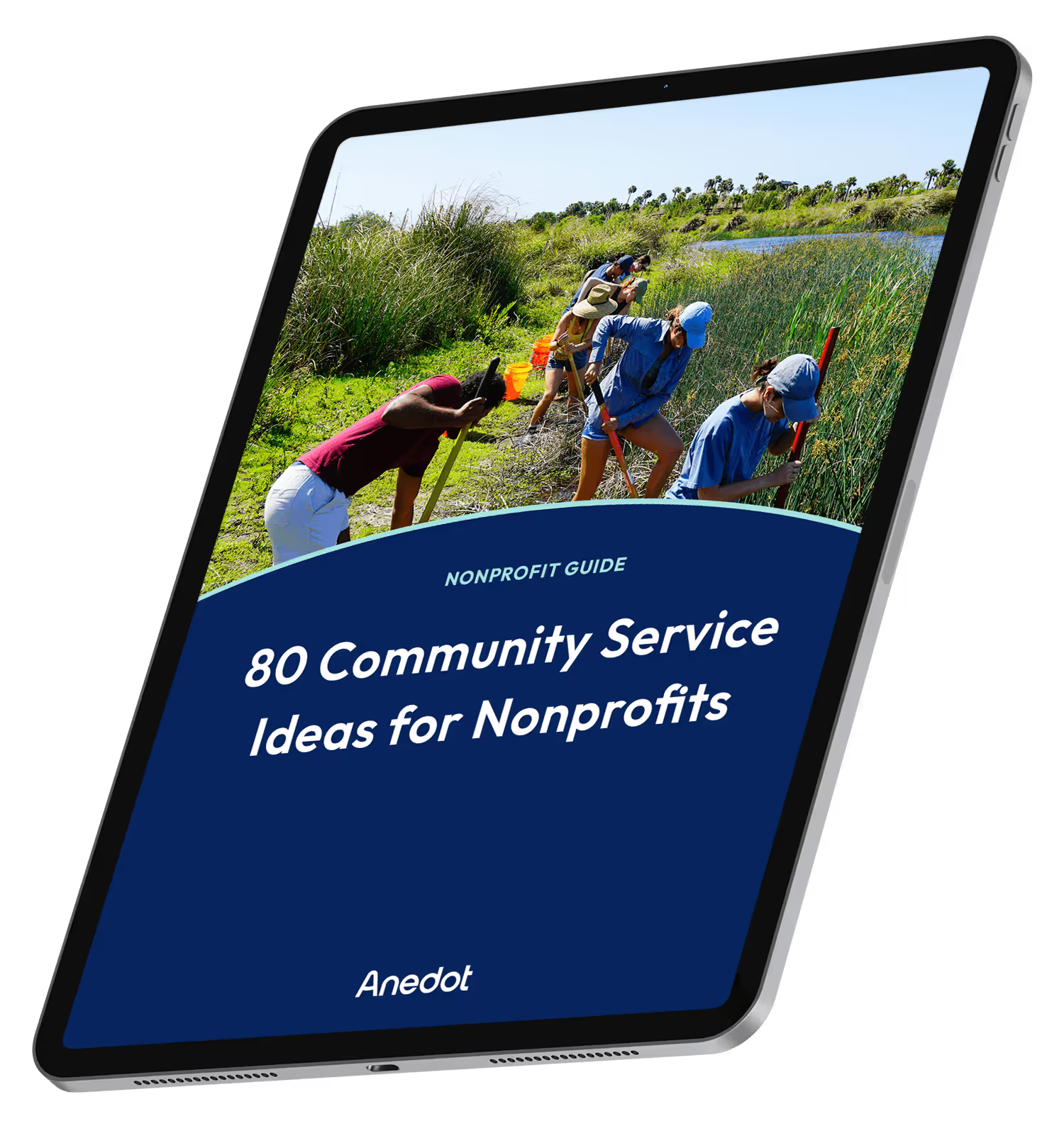
80 Community Service Ideas for Nonprofits
